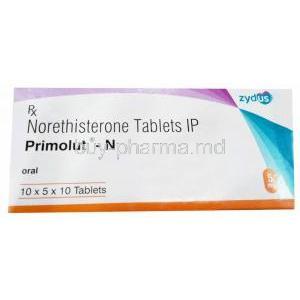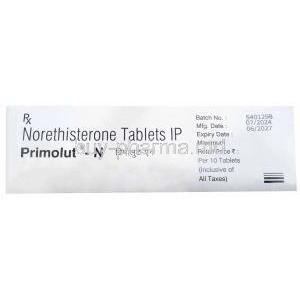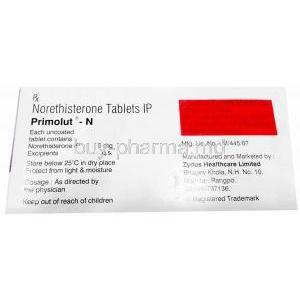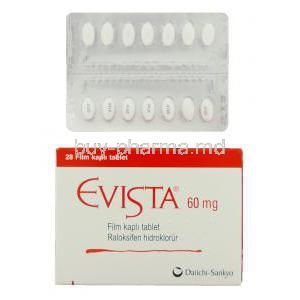Introduction
Norethisterone is a synthetic progestin widely utilized for its potent hormonal regulation properties. It mimics the natural hormone progesterone, influencing reproductive and endocrine functions. This medication has diverse medical applications, particularly in managing menstrual disorders and hormone-related conditions.
Classified as a second-generation progestin, norethisterone exhibits strong progestogenic activity, making it a preferred choice in various therapeutic settings. Its significance extends across gynecology, endocrinology, and contraception.
Regulatory bodies such as the FDA, EMA, and MHRA have approved norethisterone for several indications, ensuring its efficacy and safety in clinical use. The drug is available globally, either by prescription or over-the-counter, depending on regional regulations.
Composition and Formulation
Norethisterone is composed of:
- Active ingredient: Norethisterone (also called norethindrone), which exerts progestogenic effects.
- Available strengths: Typically found in 5 mg oral tablets, lower doses in contraceptive formulations, and injectable forms.
- Excipients: Inactive substances such as lactose monohydrate, magnesium stearate, and microcrystalline cellulose that enhance stability and bioavailability.
How Norethisterone Works
Norethisterone modulates the hormonal system by binding to progesterone receptors. This interaction influences reproductive physiology and menstrual cycle dynamics.
- Endocrine effects: Suppresses ovulation by inhibiting gonadotropin release.
- Menstrual regulation: Stabilizes the endometrium, preventing irregular shedding.
- Contraceptive action: Thickens cervical mucus, hindering sperm penetration.
Its dual role as both a contraceptive and therapeutic agent makes it versatile in gynecological treatment.
Approved Uses of Norethisterone
Treatment of Menstrual Disorders
- Irregular menstruation: Helps normalize cycle irregularities caused by hormonal imbalances.
- Heavy menstrual bleeding (menorrhagia): Reduces excessive endometrial proliferation.
- Painful periods (dysmenorrhea): Relieves cramping by modulating prostaglandin activity.
Management of Endometriosis
Alleviates endometrial lesions by inducing a hypoestrogenic state, reducing pain and disease progression.
Hormonal Contraception
Used in combination or as a progestin-only contraceptive to prevent pregnancy.
Postponement of Menstruation
Delays menstruation when taken continuously, a common practice for travel or special occasions.
Treatment of Premenstrual Syndrome (PMS)
Regulates hormonal fluctuations to reduce symptoms such as mood swings and bloating.
Use in Hormone Replacement Therapy (HRT) for Menopausal Symptoms
Counteracts estrogen dominance in HRT, preventing endometrial hyperplasia.
Off-Label Uses of Norethisterone
- Management of Polycystic Ovary Syndrome (PCOS): Balances progesterone levels to regulate ovulation.
- Abnormal uterine bleeding: Controls excessive or irregular bleeding.
- Recurrent miscarriage: Supports luteal phase insufficiency in select cases.
- Androgen suppression: Used in hormone therapy for transgender individuals.
- Endometrial hyperplasia prevention: Administered alongside estrogen therapy.
Dosage and Administration
Dosage varies based on indication:
- Menstrual disorders: 5 mg daily for 10–14 days.
- Endometriosis: 5–15 mg daily, continuous or cyclical regimen.
- Contraception: 0.35 mg daily, taken continuously.
Dosage Adjustments
May require modification based on:
- Age and hormonal status.
- Comorbid conditions such as liver dysfunction.
- Concurrent medication use.
Missed Dose Instructions
If a dose is missed:
- Take as soon as remembered.
- If near the next dose, skip the missed one.
- Avoid doubling doses.
Side Effects of Norethisterone
Common Side Effects
- Nausea and vomiting: Mild gastrointestinal discomfort, often transient.
- Headache and dizziness: Due to hormonal fluctuations.
- Breast tenderness: Temporary sensitivity or swelling.
- Mood changes: Depression or irritability in some individuals.
- Altered libido: Changes in sexual desire.
Less Common but Serious Side Effects
- Thromboembolism risk: Increased risk of deep vein thrombosis (DVT) and pulmonary embolism.
- Liver dysfunction: Rare cases of jaundice or hepatic impairment.
- Elevated blood pressure: Monitoring required for hypertensive individuals.
- Allergic reactions: Skin rashes or hypersensitivity reactions.
Regular medical supervision is essential to mitigate adverse effects.
Drug Interactions with Norethisterone
Norethisterone's pharmacokinetics and efficacy can be significantly influenced by concomitant medication use. Certain drugs may either reduce its effectiveness or exacerbate side effects, necessitating careful consideration and medical supervision.
Medications That May Reduce Effectiveness
Several classes of drugs can accelerate the metabolism of norethisterone, leading to subtherapeutic plasma concentrations and reduced efficacy:
- Certain antibiotics: Rifampin and rifabutin induce hepatic enzymes, accelerating norethisterone breakdown.
- Antiepileptic drugs (phenytoin, carbamazepine): Potent cytochrome P450 inducers that expedite hormonal clearance.
- HIV medications: Protease inhibitors and non-nucleoside reverse transcriptase inhibitors can interfere with norethisterone metabolism.
- Herbal supplements (St. John’s Wort): Enhances hepatic enzyme activity, potentially compromising therapeutic efficacy.
Interactions That May Increase Side Effects
Some medications can potentiate norethisterone’s effects, elevating the risk of adverse reactions:
- Estrogen-containing medications: Can exacerbate thromboembolic risks due to additive hormonal influence.
- Corticosteroids and immunosuppressants: Potential for increased systemic corticosteroid levels due to enzyme competition.
Warnings and Contraindications
Norethisterone is contraindicated in specific conditions where its use poses significant health risks. Patients should undergo a comprehensive evaluation before initiation.
Conditions Where Use Is Not Recommended
- History of blood clots or thromboembolic disorders: Increased risk of deep vein thrombosis (DVT), pulmonary embolism, or stroke.
- Active liver disease: Potential for hepatic impairment due to hormonal metabolism.
- Unexplained vaginal bleeding: Requires diagnostic clarification before initiating treatment.
- Hormone-sensitive cancers: Contraindicated in breast and endometrial malignancies.
Risks Associated with Long-Term Use
- Prolonged exposure may elevate cardiovascular risks, including hypertension and arterial thromboembolism.
- Possible disruption of lipid metabolism and glucose tolerance.
Important Precautions Before Use
Prior to initiating norethisterone therapy, thorough patient assessment is essential to ensure safe administration.
Pre-Treatment Screening and Medical History Assessment
- Evaluation of thrombotic risk factors, including family history.
- Liver function tests to rule out hepatic insufficiency.
- Baseline cardiovascular assessment for patients with predisposing conditions.
Monitoring Requirements During Therapy
- Regular blood pressure checks to detect hypertensive changes.
- Monitoring for breakthrough bleeding, which may indicate endometrial instability.
- Lipid profile evaluations in patients with dyslipidemia.
Signs and Symptoms Requiring Immediate Discontinuation
- Severe headaches, visual disturbances, or focal neurological symptoms (indicative of stroke risk).
- Unexplained leg swelling or chest pain (possible thromboembolic event).
- Jaundice or significant liver enzyme elevation.
Managing Potential Side Effects Proactively
- Use of adjunctive therapies (e.g., antiemetics for nausea, NSAIDs for menstrual pain).
- Lifestyle modifications, including dietary adjustments for metabolic concerns.
Special Populations and Considerations
Use in Elderly Patients
Hormonal therapy in postmenopausal individuals necessitates caution due to heightened cardiovascular risks.
- Increased susceptibility to thrombotic complications.
- Monitoring for metabolic disturbances, such as glucose intolerance.
Use in Pregnant Women and Nursing Mothers
Norethisterone is generally contraindicated during pregnancy due to potential fetal risks.
- Risk of masculinization in female fetuses if taken during early gestation.
- Possible suppression of lactation when used during breastfeeding.
Use in Children and Adolescents
Limited data on long-term safety in younger populations necessitates cautious use.
- Primarily indicated for menstrual cycle regulation in adolescent females.
- Close monitoring for bone mineral density changes in prolonged therapy.
Overdosage and Toxicity Management
Symptoms of Overdose
Excessive norethisterone intake can lead to a spectrum of adverse effects:
- Nausea, vomiting, and gastrointestinal distress.
- Breast tenderness and fluid retention.
- Breakthrough bleeding due to hormonal dysregulation.
Immediate Steps for Management
- Discontinue medication and provide symptomatic relief.
- Induce gastric lavage in cases of severe overdose (within a short timeframe).
- Administer activated charcoal if ingestion is recent.
When to Seek Emergency Medical Attention
- Severe neurological symptoms such as confusion or seizures.
- Respiratory distress or acute cardiovascular instability.
Storage and Handling Precautions
Recommended Storage Conditions
- Store at room temperature (15°C–25°C) in a dry environment.
- Protect from direct sunlight and moisture to prevent degradation.
Shelf Life and Expiration Guidelines
- Check expiration date before use; do not consume expired medication.
- Observe for any changes in tablet integrity, such as discoloration.
Safe Disposal of Expired or Unused Medication
- Dispose of through designated pharmaceutical waste programs.
- Avoid flushing down toilets or discarding in household waste.
Handling Precautions for Healthcare Providers
- Wear gloves when handling large quantities in pharmaceutical settings.
- Avoid inhalation of powdered formulations if compounding is required.
Norethisterone FAQ
- What can norethisterone be used for?
- Is norethisterone used to stop periods?
- How long after taking norethisterone will my next period start?
- What happens to your body when you take norethisterone?
- When is it best to take norethisterone?
- Will I get pregnant on norethisterone?
- Will Norethindrone stop my period?
- Can norethisterone terminate early pregnancy?
- Can I buy norethisterone over the counter?
- What is norethisterone used for?
- Who cannot take norethisterone?
- What are the side effects of norethindrone?
- Can you get pregnant on norethisterone?
- What are the positive effects of norethisterone?
- How quickly will norethisterone stop my period?
- How many days do you bleed after taking norethisterone?
- When is the best time to take norethindrone?
- Can you get pregnant on norethindrone?
- How safe is norethisterone?
- Is norethindrone safe?
- Can norethisterone affect early pregnancy?
- Can norethisterone stop your period early?
- What are the benefits of norethindrone?
What can norethisterone be used for?
- Frequent bleeding, during menstruation
- Discomfort during menstruation cycles or unusually frequent periods
- Premature menstrual symptoms (PMS)
- Occurrence of endometrial tissue outside the uterus, known as endometriosis
- Breast cancer risks and concerns.
Is norethisterone used to stop periods?
Yes
How long after taking norethisterone will my next period start?
2-3 days later
What happens to your body when you take norethisterone?
- breast soreness,
- dizziness,
- headache,
- nausea,
- stomach pain
- vaginal spotting
When is it best to take norethisterone?
Once a day, either evening or bedtime
Will I get pregnant on norethisterone?
Yes
Will Norethindrone stop my period?
Noresthisterone is a medication for delaying periods.
Can norethisterone terminate early pregnancy?
No
Can I buy norethisterone over the counter?
No
What is norethisterone used for?
A few days before your period is expected to begin, taking tablets can delay the shedding of the lining of the womb and consequently postpone or prevent your period temporarily.
Who cannot take norethisterone?
Do not use Norethisterone if you have allergies to norethisterone or similar hormonal medications or any components of the treatment; if you suspect pregnancy; or if you have had unexplained bleeding that your doctor couldn't identify the cause for in the past.
What are the side effects of norethindrone?
Bleeding in the area or spotting, alterations in the menstrual cycle, swollen or sensitive breasts, feelings of nausea, throwing up, feeling bloated, fluctuations in weight, and difficulty falling asleep or staying asleep.
Can you get pregnant on norethisterone?
Taking medication to postpone your cycle does not provide protection against pregnancy; therefore, having intercourse while on Norethisterone may lead to conception.
What are the positive effects of norethisterone?
NET has impacts on the endometrium that make it an effective option for managing uterine bleeding and conditions like endometriosis and endometrial hyperplasia. Additionally, NET can enhance bone mineral density. Have either neutral effects on heart health.
How quickly will norethisterone stop my period?
Up to 17 days
How many days do you bleed after taking norethisterone?
1 week
When is the best time to take norethindrone?
Evening meal or bedtime
Can you get pregnant on norethindrone?
Yes
How safe is norethisterone?
Most women can safely use Norethisterone. It's not recommended for use due to potential side effects like nausea, breast tenderness, fatigue, and headaches that some individuals may experience when taking it.
Is norethindrone safe?
Taking norethindrone for birth control can significantly raise the chances of developing blood clots or experiencing a stroke or heart attack.
Can norethisterone affect early pregnancy?
It's important to avoid taking Norethisterone Tablets if you're pregnant since hormonal medications may have an impact on the baby's development.
Can norethisterone stop your period early?
If you begin taking it on the day of your cycle as directed by your healthcare provider or pharmacists' instructions, do not expect it to completely halt your period flow.
What are the benefits of norethindrone?
It helps with managing periods. It can be effective in alleviating pain caused by endometriosis by boosting progesterone levels in the body.























